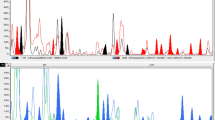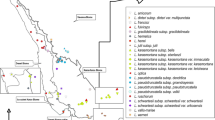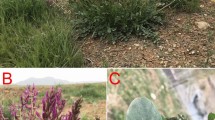Abstract
Genetic diversity was described in 17 cedar populations covering the geographical range of the four species of the genus Cedrus. The study was conducted using amplified fragment length polymorphism (AFLP) on haploid tissues (megagametophytes). Eleven selective AFLP primer pairs generated a total of 107 polymorphic amplification products. Correspondence and genetic distance analyses indicated that Cedrus deodara constitutes a separate gene pool from the Mediterranean cedars. Within Mediterranean cedars, we distinguished two groups: the first one is made of Cedrus atlantica, while the second one is made of Cedrus libani and Cedrus brevifolia, these latter two species being genetically similar despite important divergence previously observed for morphological and physiological traits. The lowest intrapopulation variability was found in the two C. deodara populations analyzed. Surprisingly, C. brevifolia, the endemic taxon from the island of Cyprus that is found in small and fragmented populations, showed one of the highest levels of diversity. This unexpected pattern of diversity and differentiation observed for C. brevifolia suggests a recent divergence rather than a relictual, declining population. Patterns of diversity within- and among-populations were used to test divergence and fragmentation hypotheses and to draw conclusions for the conservation of Cedrus gene pools.



Similar content being viewed by others
References
Alptekin CU, Bariteau M, Fabre JP (1997) Le cédre de Turquie: aire naturelle, insectes ravageurs, perspectives d’utilisation pour le reboisement en France. Rev For Fr 49:19–31
Arbez M, Ferrandes P, Uyar N (1978) Contribution à l’étude de la variabilité géographique des cèdres. Ann Sci For 35:265–284
Bariteau A, Ferrandes P (1992) Les cédres. In: Gallais A, Bannerot H (eds) L’amélioration des plantes. INRA Editions, Versailles, pp 732–750
Belkhir K, Borsa P, Chikhi L, Raufaste N, Bonhomme F (2004) GENETIX 4.05, Population genetics software for Windows TM. Laboratoire Génome, Populations, Interactions, CNRS UMR 5000, Université de Montpellier II, Montpellier
Bou Dagher-Kharrat M, Grenier G, Bariteau M, Brown S, Siljak-Yakovlev S, Savouré A (2001) Karyotype analysis reveals interspecific differentiation in the genus Cedrus despite genome size and base composition constancy. Theor Appl Genet 103:846–854
Chaney WR, Basbous M (1978) The cedars of Lebanon, witnesses of history. Econ Bot 32:120–123
Cointat M (1996) Le roman du cédre. Rev For Fr 48:503–517
Davis PH (1965) Flora of Turkey and East Aegean Islands, vol. I. Edinburgh University Press, Edinburgh
Debazac EF (1964) Manuel des conifères. ENGREF, Nancy
Doyle JJ, Doyle JL (1990) Isolation of plant DNA from fresh tissue. Focus 12:13–15
Ellstrand NC, Elam DR (1993) Population genetic consequences of small population size: implications for plant conservation. Annu Rev Ecol Syst 24:217–242
Fabre JP, Bariteau M, Chalon A, Thevenet J (2001) Possibilités de multiplication de pucerons Cedrobium laportei Remaudiére (Homoptera, Lachnidae) sur différentes provenances du genre Cedrus et sur deux hybrides d’espéces, perpectives d’utilisation en France. International Meeting on Sylviculture of cork oak (Quercus suber L.) and Atlas cedar (Cedrus atlantica Manetti), Rabat, Morocco, pp 83–94
Fady B (2005) Is there really more biodiversity in Mediterranean forest ecosystems? Taxon 4:905–910
Fady B, Bariteau M, Fallour D, Giroud E, Lefèvre F (2000) Isozyme gene markers and taxonomy of Mediterrannean Cedrus species. In: Panetsos K (eds) Adaptation and selection of Mediterranean Pinus and Cedrus for sustainable afforestation of marginal lands. Proceedings of the final conference of the EU project FAIR CT95-0097. Aristotelian University of Thessaloniki, Mytilene, pp 21–26
Fady B, Lefèvre F, Reynaud M, Vendramin GG, Bou Dagher-Kharrat M, Anzidei M, Pastorelli R, Savouré A, Bariteau M (2003) Gene flow among different taxonomic units: evidence from nuclear and cytoplasmic markers in Cedrus plantation forests. Theor Appl Genet 107:1132–1138
FAO (1986) Databook on endangered tree and shrub species and provenances. In: FAO. Forestry paper 77, Food and Agriculture Organization of the United Nations, Rome
Greuter W, Burdet HM, Long G (1984) Med-Checklist. vol. 1, Pteridophyta Gymnospermae Dicotylidonae (Acanthaceae-Gneoraceae), 2nd edn. Conservatoire et jardin Botanique de la ville de Genéve, Geneva
Hoerling M, Kumar A (2004) The perfect ocean for drought. Science 299:691–694
Khuri S, Talhouk SN (1999) Cedars of Lebanon Cedrus libani A. Rich. In: Farjon A, Page CN (eds) Conifers: status survey and conservation action plan, IUCN, Gland, Switzerland, pp 108–111
Ladjal M (2001) Variabilité de l’adaptation á la sécheresse des cèdres méditerranéens (Cedrus atlantica, C. brevifolia et C. libani), aspects écophysiologiques. Ph.D. Thesis, University of Nancy I, France
Lefèvre F, Achard P, Azais D, Smulders MJM, van der Schoot J, Bovenschen J, Ivens B, Storme V, Fluch S, Krystufek V, Castiglione S (2002) Distribution of Populus nigra genetic diversity within France and its consequences for ex situ conservation strategy. In: van Dam BC, Bordacs S (eds) Genetic diversity in river populations of European black poplar, Csiszar Nyomda, Budapest, pp 85–91
Lefèvre F, Fady B, Fallour-Rubio D, Ghosn D, Bariteau M (2004) Impact of founder population, drift and selection on the genetic diversity of a recently translocated tree population. Heredity 93:542–550
Mantel N (1967) The detection of disease clustering and a generalised regression approach. Cancer Res 27:209–220
Mariette S, Cottrell J, Csaikl UM, Goikoechea A, Konig AJ, Lowe BC, van Dam T, Barreneche C, Bodénès R, Streiff K, Burg K, Groppe R C, Munro H, Tabbener D, Kremer A (2002) Comparison of levels of genetic diversity detected with AFLP and microsatellite markers within and among mixed Quercus petraea (Matt.) Liebl. and Q. robur L. stands. Silvae Genet 51:72–79
Maruyama T, Fuerst PA (1985) Population bottlenecks and nonequilibrium models in population genetics. II. Number of alleles in a small population that was formed by a recent bottleneck. Genetics 111:675–689
McKay JK, Latta RG (2002) Adaptive population divergence: markers, QTL and traits. Trends Ecol Evol 17:285–291
Miller MP (1997) Tools for population genetic analysis (TFPGA), version 1.3. A Windows program for the analysis of allozyme and molecular population genetic data. Department of Biological Sciences, Northern Arizona University, Flagstaff
Nei M (1973) Analysis of gene diversity in subdivided populations. Proc Natl Acad Sci USA 70:3321–3323
Nei M (1978) Estimation of average heterozygosity and genetic distance from a small number of individuals. Genetics 89:583–590
Pons A (1998) L’histoire du genre Cedrus d’aprés les données paléobotaniques disponibles. For Méditerr 14:236–242
Pons O, Petit RJ (1995) Estimation, variance and optimal sampling of gene diversity. Theor Appl Genet 90:462–470
Quézel P (1998) Cèdres et cédraies du pourtour méditerranéen: signification bioclimatique et phytogéographique. For Méditerr 19:243–260
Quézel P, Médail F (2003) Ecologie et biogéographie des forêts du bassin méditerranéen. Elsevier, Paris
Renau-Morata B, Nebauer SG, Sales E, Allainguillaume J, Caligari P, Segura J (2005) Genetic diversity and structure of natural and managed populations of Cedrus atlantica (Pinaceae) assessed using random amplified polymorphic DNA. Am J Bot 92:875–884
Roa A, Maya M, Duque M, Tohme J, Allem AC, Bonierbale MW (1997) AFLP analysis of relationships among cassava and other Manhiot species. Theor Appl Genet 95:741–750
Scaltsoyannes A (1999) Allozyme differentiation and phylogeny of cedar species. Silvae Genet 48:61–68
Tohme J, Gonzalez D, Beebe S, Duque M (1996) AFLP analysis of gene pools of a wild bean core collection. Crop Sci 36:1375–1384
Toth J (1984) Quelques éléments nouveaux pour mieux situer et caractériser le cèdre de l’Himalaya vis-á-vis du cèdre de l’Atlas et du cédre du Liban en France méridionale. Bull Soc Et Sci Nat, Vaucluse, pp 41–49
Tutin TG, Heywood VH, Burges NA, Moore DM, Valentine DH, Walters SM, Weeb DA (1964) Flora Europea, vol. 1. Cambridge University Press, Cambridge, UK
Vidakovic M (1991) Conifers. In: Brekalo B (eds) Morphology and variation. Graficki Zavod, Hrvatske, pp 129–136
Vos P, Hogers R, Bleeker M, Reijans M, van de Lee T, Hornes M, Frijters A, Pot J, Peleman J, Kuiper M (1995) AFLP: a new technique for DNA fingerprinting. Nucleic Acids Res 23:4407–4414
Winfield MO, Arnold GM, Cooper F, Le Ray J, White M, Karp A, Edwards KJ (1998) A study of genetic diversity in Populus nigra subsp. betufolia in the Upper Severn area of the UK using AFLP markers. Mol Ecol 7:3–10
Acknowledgements
We would like to thank Drs. Michel Bariteau (France), Zeki Kaya, Fikret Isik (Turkey), Youssef Bardouka (Syria), Nizar Hani (Lebanon), and Neophyton (Cyprus) for supplying cedar seeds. This work was supported by an INCO-DC program (ERBIC 18CT 970 200).
Author information
Authors and Affiliations
Corresponding author
Additional information
Communicated by D. Grattapaglia
Rights and permissions
About this article
Cite this article
Dagher-Kharrat, M.B., Mariette, S., Lefèvre, F. et al. Geographical diversity and genetic relationships among Cedrus species estimated by AFLP. Tree Genetics & Genomes 3, 275–285 (2007). https://doi.org/10.1007/s11295-006-0065-x
Received:
Revised:
Accepted:
Published:
Issue Date:
DOI: https://doi.org/10.1007/s11295-006-0065-x




